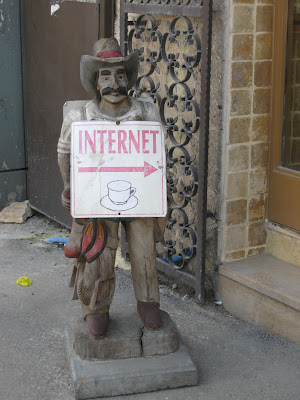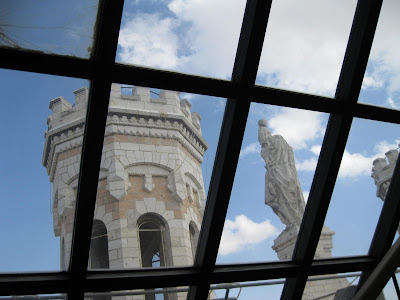Exactly during the week of Purim (whose story takes place in the Persian Empire) we in Israel were treated to some [this time] good news items about our current Iranian connection.
First, the opening of a 24/7 radio station in the Persian language. Amir Shai, the station's manager, said, "The Persian radio is composed of Israelis like us that speak the language and would like to preserve our heritage, and give PR to the outside world, beyond Israel."
Their Ynet article about it is
here, and the Radis IN website is
here.
AND the Israel Antiquities Authority announced the discovery in Jerusalem of a rare inscription on 12th or 13th century pottery: part of Omar Khayyam's
Rubaiyat!
The whole story from the IAA website is copied below.
Finally, thanks to all of you who wrote good comments on my posts of March 3rd and 4th about gas masks and the first Gulf War. You may have missed the comments which came in later. I urge you to read the contribution by Meead, an Iranian blogger, who tells of his memories as a young boy in the 1980-88 Iraq-Iran war. Please click
here for his story.
<><><><><
UPDATE! -- Meead has just posted his own translation of the love poem written on the old jug. It is much better than the one below. He also shows us pages of art and calligraphy in his own sumptuous copy of the
Rubaiyat. Don't miss it at his
Portland Daily Photo blog!
Photo by Clara Amit
A
press release from the Press Office of the Israel Antiquities Authority:
A Persian Love Poem (9/3/2009)
A jug inscribed with a Persian love poem was discovered in excavations of the Israel Antiquities Authority in the Old City of Jerusalem
A fragment of a pottery vessel of Persian provenance that dates to the Middle Ages (12th-13th centuries CE) was discovered in an archaeological excavation directed by Dr. Rina Avner, on behalf of the Israel Antiquities Authority, in the Old City of Jerusalem, prior to construction by a private contractor.
The fragment is treated with a turquoise glaze and is adorned with floral patterns and a black inscription. While studying the artifact prior to publication, Rivka Cohen-Amin of the Israel Antiquities Authority discerned that the inscription on the neck of the vessel is written in Persian. The inscription consists of a line that was taken from a quatrain. The inscription, which was translated by Dr. Julia Rabanovich of the Hebrew University of Jerusalem, reads: “Was once the embrace of a lover that entreat”.
The inscription will be published by Dr. Nitsan Amitai-Preiss of the Ben-Gurion University of the Negev, within the framework of the final excavation report.
According to Rivka Cohen-Amin the words are from the Rubaiyat, by the poet Omar Khayyam. Omar Khayyam was an astronomer, mathematician and one of the most famous Persian poets of the Middle Ages (11th-12th centuries CE).
The following is the complete translation of the poem:
Rubaiyat, by Omar Khayyam
این کوزه چو من عاشق زاری بوده است
This clay pot like a lover once in heat
در بند سر زلف نگاری بودهست
A lock of hair his senses did defeat
ایندسته که بر گردن او میبینی
The handle that has made the bottleneck its own seat
دستیست که برگردن یاری بودهست
Was once the embrace of a lover that entreat
The phenomenon of a Persian pottery vessel inscribed with a poem is known elsewhere in the world; however, this is the first occurrence of such a vessel in Israel.
The question of how the vessel came to be in Jerusalem is a mystery – was it brought here by merchants or could it possibly have been a gift someone presented to his Jerusalemite lover?
 Following Jewish tradition we each wrote a kvittel (the Yiddish word for a little note) to God,
Following Jewish tradition we each wrote a kvittel (the Yiddish word for a little note) to God, folded them up, and pushed them into spaces between the ancient stones.
folded them up, and pushed them into spaces between the ancient stones. But I heard some strange sounds from over in the men's section.
But I heard some strange sounds from over in the men's section.














































